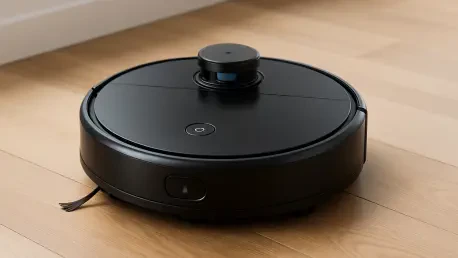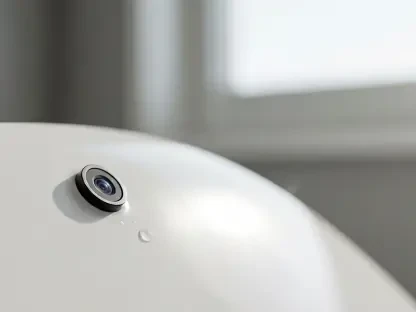In an era where smart home devices are becoming indispensable, the SwitchBot S20 has emerged as a compelling contender in the realm of automated cleaning, blending the roles of a robot vacuum and mop with striking innovation. Launched in September of this year, this hybrid device has quickly captured attention with its promise to revolutionize floor care through a sophisticated mopping system and robust vacuuming power. Priced at $799.99 in the US and £799.99 in the UK, it sits in the premium segment, though frequent discounts often bring it down to a more accessible mid-range cost, sometimes as low as $448 in the US. The question looms large: does this bot truly deliver on its bold claims to be a game-changer, particularly in mopping performance? TechRadar’s comprehensive review, authored by their Homes Editor, provides a detailed examination of its capabilities, revealing a mix of groundbreaking features and operational quirks. This analysis aims to unpack the S20’s strengths and limitations, offering a clear perspective on whether it can claim the title of the ultimate cleaning companion for modern households. From its cutting-edge design to real-world performance, every aspect will be explored to determine if this device meets the high expectations set by its marketing and initial buzz in the smart home market.
Mopping Mastery: A New Standard in Floor Care
The SwitchBot S20 distinguishes itself primarily through its exceptional mopping capabilities, setting a benchmark that many hybrid robots struggle to match. Unlike conventional models that rely on flat pads often ineffective at deep cleaning, this device employs a roller mop that exerts 1 kg of pressure to scrub hard floors with remarkable efficiency. The accompanying docking station enhances this feature by supplying fresh water continuously and using a scraper to clean the roller, ensuring that dirt is not redistributed across surfaces. Tests highlighted by TechRadar demonstrate its prowess in handling liquid spills like soy sauce on tiled floors, leaving behind minimal residue. The dock’s ability to drain dirty water into a separate tank and dry the mop with warm air at 122°F adds a layer of convenience that reduces manual maintenance. For households dominated by hard flooring, this system represents a significant leap forward, offering a level of cleanliness that rivals manual mopping in many scenarios.
However, perfection remains elusive even in this standout feature of the S20. One noted limitation is the time it takes for the roller to become fully saturated, often requiring a near-complete cleaning cycle before achieving consistent wet tracks across the floor. Thicker, stickier messes such as smeared ketchup pose additional challenges, with the bot sometimes leaving traces behind despite its scrubbing power. These minor hiccups, while not dealbreakers, suggest that certain types of spills may still require manual intervention for complete removal. Nevertheless, the overall mopping performance, bolstered by automated maintenance through the dock, positions this robot as a top choice for those prioritizing pristine hard floors over other cleaning needs. It’s a feature that could sway many potential buyers looking for a device to handle the bulk of their floor care with minimal oversight.
Vacuuming Capabilities: Reliable but Restricted
Turning to vacuuming, the SwitchBot S20 offers commendable performance driven by a substantial 10,000 Pa suction power, capable of tackling a variety of household debris. It manages dust, pet hair, and larger particles like oats on carpets with relative ease, particularly when set to its Max suction mode. TechRadar’s evaluation points to its effectiveness in picking up finer debris as well, though it excels more noticeably with bulkier messes. This makes the device a dependable option for maintaining day-to-day cleanliness across different floor types, providing a solid foundation for households with pets or high foot traffic. The suction strength ensures that most surface-level dirt is captured efficiently, reducing the need for frequent manual cleanups in many common scenarios.
Yet, a significant limitation emerges when the S20 attempts to switch between mopping and vacuuming tasks, revealing a design quirk that hampers its versatility. If the mop roller remains damp from a prior mopping session, it can smear debris across hard floors rather than collecting it, creating more mess than it resolves. This necessitates a separation of cleaning modes, with mopping ideally performed as the final task to avoid such issues. For homes with mixed flooring—where carpets and hard surfaces coexist—this operational constraint could prove inconvenient, requiring users to plan cleaning schedules carefully. While the vacuuming ability stands strong on its own, this integration flaw diminishes the appeal of the S20 as a seamless all-in-one cleaning solution for diverse environments.
Navigation Technology: Impressive yet Inconsistent
Equipped with advanced technology like a front-mounted AI camera and LiDAR SLAM navigation, the SwitchBot S20 showcases remarkable skill in obstacle avoidance, a critical aspect of robotic cleaning. It adeptly maneuvers around common household items such as charging cables, shoes, and even furniture, demonstrating a level of spatial awareness that sets it apart from many competitors. TechRadar’s testing revealed moments of brilliance, such as the bot’s ability to navigate around a coffee table to complete an area clean, a feat that underscores its intelligent design. This capability ensures that cleaning sessions are less likely to be interrupted by tangled cords or misplaced objects, offering peace of mind to users who value uninterrupted operation in cluttered spaces.
Despite these strengths, the navigation system of the S20 isn’t without its shortcomings, as it occasionally exhibits erratic behavior that can disrupt efficiency. The bot sometimes deviates from logical cleaning patterns, taking unexpected paths that prolong cleaning times unnecessarily. Struggles with taller room thresholds also surface, though it often manages to surmount them after repeated attempts. Additionally, its ultra-sensitive obstacle detection can be overly cautious, as seen when it initially avoided a puddle during mopping, mistaking it for a solid object. These inconsistencies might test the patience of users expecting flawless movement, suggesting that while the technology is advanced, there’s still room for refinement to achieve a consistently smooth cleaning experience across varied home layouts.
Usability Challenges: Noise and Practicality Concerns
When it comes to usability, the SwitchBot S20 presents a mixed bag, with noise levels emerging as a prominent concern for many potential buyers. TechRadar’s review describes the device as louder than average across all cleaning modes, with the auto-emptying process at the dock generating particularly disruptive sounds, potentially among the noisiest encountered in testing. This high decibel output could pose a significant drawback in households with young children, pets, or individuals sensitive to sound, necessitating careful consideration of when and where the bot operates. For those living in smaller spaces or shared environments, this aspect might overshadow some of the device’s more innovative features, impacting its overall suitability.
Beyond the noise issue, additional practical challenges arise that affect the day-to-day experience of using the S20. The absence of a dedicated “mop only” mode feels like an oversight, especially given the bot’s exceptional mopping strength, limiting user flexibility in tailoring cleaning tasks. Furthermore, the larger-than-average size of both the robot and its dock may not mesh well with compact living spaces, contrasting with the brand’s reputation for smaller, more discreet designs. These usability quirks require potential buyers to weigh the device’s advanced capabilities against the practical realities of their home environment, as spatial constraints and noise tolerance could significantly influence satisfaction with this hybrid cleaning solution.
App Functionality: Convenient but Clunky
The companion app for the SwitchBot S20 provides a functional platform for controlling the device, offering options to adjust suction levels across modes like Quiet, Standard, Strong, and Max, as well as mopping wetness settings. Its integration with other smart home products from the same ecosystem adds value for users already invested in the brand’s lineup, allowing for a cohesive control experience. Key functions are presented in a relatively straightforward manner, ensuring that most adjustments can be made with minimal effort. Compatibility with broader smart home systems via Matter support further enhances its appeal, enabling seamless interaction with platforms like Apple Home, Alexa, and Google Home for a connected household setup.
However, the app experience is marred by several small but frustrating limitations that detract from its overall usability. Challenges in creating precise room divisions on the digital map hinder accurate customization of cleaning zones, while an arbitrary eight-character limit on room names feels unnecessarily restrictive. Navigating through multiple screens to access specific vacuum controls can also become tedious, particularly for users not utilizing other products within the ecosystem. TechRadar’s insights suggest that while the app serves its primary purpose, these interface quirks introduce unnecessary friction, pointing to a need for future updates to streamline functionality and elevate the user experience to match the hardware’s advanced features.
Design Dynamics: Form Meets Function with Trade-offs
In terms of design, the SwitchBot S20 leans toward functionality over compactness, sporting dimensions that are notably larger than many contemporary robot vacuums at 14.4 inches in diameter and 4.5 inches in height. The accompanying dock is equally substantial, measuring significant space to accommodate its multifaceted role in dust emptying, water management, and mop drying. This build supports the device’s innovative mopping and maintenance systems, ensuring that key features operate with minimal user input. Physical buttons provide basic onboard control, though most operations are app-driven, aligning with modern smart home expectations. The design’s robustness is evident in its ability to handle complex tasks autonomously, appealing to those seeking a hands-off cleaning approach.
Yet, the larger footprint of both the bot and dock introduces practical considerations that may not suit every household. Its size can limit maneuverability under low furniture or in tight corners, potentially leaving some areas less accessible compared to slimmer alternatives. Additionally, the absence of edge-cleaning enhancements, such as side-kicking mop rollers, means it may not reach every nook as effectively as some premium competitors. While the design prioritizes the integration of advanced features, it sacrifices the compactness that many associate with the brand’s earlier models. Users must assess whether their living space can accommodate this bulkier setup without compromising the overall cleaning efficiency they expect from a high-end hybrid device.
Value Assessment: Price Versus Performance
At its launch price of $799.99 in the US and £799.99 in the UK, the SwitchBot S20 positions itself in the premium category, reflecting its advanced mopping system and powerful suction capabilities. However, frequent discounts—often reducing the cost by as much as 44% in the US to around $448—transform it into a more competitive mid-range option, broadening its appeal. An alternative version with an auto-fill and drain system, connecting directly to a home’s water supply, is available at the same list price, offering added convenience for those with compatible setups. This pricing flexibility suggests that value can vary significantly based on when and how the purchase is made, potentially making it a more attractive investment at certain times.
Evaluating the S20’s worth requires balancing its standout mopping performance against the operational limitations and usability challenges it presents. While the mopping capabilities and automated dock maintenance provide substantial benefits for hard floor-centric homes, issues like noise, navigation inconsistencies, and the inability to seamlessly switch between tasks temper its appeal as a universal solution. TechRadar’s analysis indicates that at full price, the justification for purchase may be questionable given these quirks, but at a discounted rate, the value proposition strengthens considerably. Prospective buyers must consider their specific cleaning priorities and whether securing a lower price aligns with their budget and expectations for a hybrid cleaning device.
Final Reflections: Weighing the Overall Impact
Looking back, the SwitchBot S20 carved a notable impression with its exceptional mopping system, supported by a self-cleaning dock that minimized manual effort, delivering impressive results on hard floors. Its vacuuming strength held up well for routine debris, though it stumbled when integrating tasks due to a damp mop roller. Navigation showed promise with advanced obstacle avoidance, yet faltered with erratic paths at times, while noise levels and a bulky design posed challenges for certain environments. The app, though functional, carried minor frustrations that hinted at needed improvements, and the pricing structure offered better value when discounts were applied.
Moving forward, potential buyers should focus on aligning the S20’s strengths with their household needs, particularly if hard floor maintenance is the primary concern. Exploring discounted offers could significantly enhance the cost-benefit ratio, making it a worthwhile investment for the right user. Considering smaller or quieter alternatives might be prudent for those constrained by space or noise sensitivity. Additionally, keeping an eye on future app updates could address current usability hiccups, potentially unlocking a smoother experience. Ultimately, assessing the home layout and cleaning priorities will guide whether this hybrid bot fits as a long-term cleaning solution, offering a pathway to smarter, more automated floor care.









